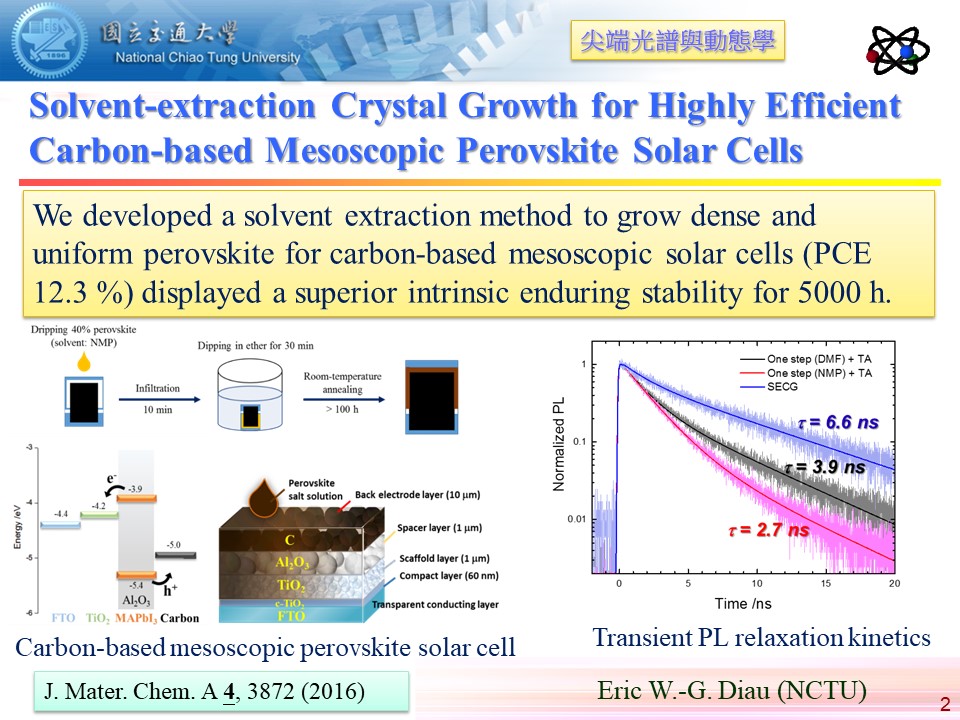

Solvent-extraction Crystal Growth for Highly Efficient Carbon-based Mesoscopic Perovskite Solar Cells
A simple drop-casting method via solvent extraction (SECG) was developed to grow dense and uniform perovskite nanocrystals at room temperature for carbon-based mesoscopic solar cells free of an organic hole-transport layer. The CH3NH3PbI3/N-methyl-2-pyrrolidone (NMP) precursor solution (40 %) was first dripped onto a substrate with film configuration TiO2/Al2O3/C and infiltrated at 70 °C for 10 min. The perovskite substrate was next immersed in a bath of diethyl ether at 25 °C for 30 min. Third, the solvent-extracted substrate was stored in a dry box (humidity 50 %) at 25 °C for at least 100 h to complete the crystal growth. The device performance attained an efficiency 12.3 % of power conversion (PCE), which is significantly greater than that of DMF (6.3 %) and NMP (8.3 %) devices using traditional thermal annealing. The SECG device displayed a superior intrinsic enduring stability: PCE exceeded 12 % for more than 5000 h. To understand the kinetics of charge transfer and defect relaxation for the devices under investigation, we recorded transient photoluminescence decays at excitation wavelength 635 nm and probe wavelength 770 nm.
* C.-Y. Chan, Y. Wang, G.-W. Wu and E. W. G. Diau, “Solvent-extraction crystal growth for highly efficient carbon-based mesoscopic perovskite solar cells free of hole conductors”, J. Mater. Chem. A 4, 3872 (2016).
Observation of Intraband Transition and Distinct Transient Species in the Infrared Region for Perovskite Solar Cells
We used nanosecond time-resolved infrared spectral technique to investigate, with high molecular specificity, distinct transient species that are formed in perovskite solar cells after photoexcitation at 532 nm. In planar-heterojuction perovskite solar cells, we simultaneously observed infrared spectral signatures that are associated with an intraband transition of conduction-band electrons, Fano resonance and the spiro-OMeTAD cation having lifetime 1.0 μs (at ~1485 cm−1). The decay of the transient IR signals (both the intraband transition and Fano-resonance features) reflects charge recombination. The rapid decay component cannot be resolved in the present experiments because the temporal resolution of our apparatus is ~80 ns. Trapped electrons would undergo slower, non-geminate recombination, which might account for the slow decay component observed. The present results show that our method offers a unique capability to elucidate these important transients in perovskite solar cells and their dynamic interplay in a comprehensive manner. We highlight that the transient charged species that are observed simultaneously in the present work could provide a quantitative measure of the degree of charge separation, charge transport and trapping.
* S. Narra, C.-C. Chung, E. W. G. Diau and S. Shigeto “Simultaneous Observation of an Intraband Transition and Distinct Transient Species in the Infrared Region for Perovskite Solar Cells”, J. Phys. Chem. Lett. 7, 2450 (2016).